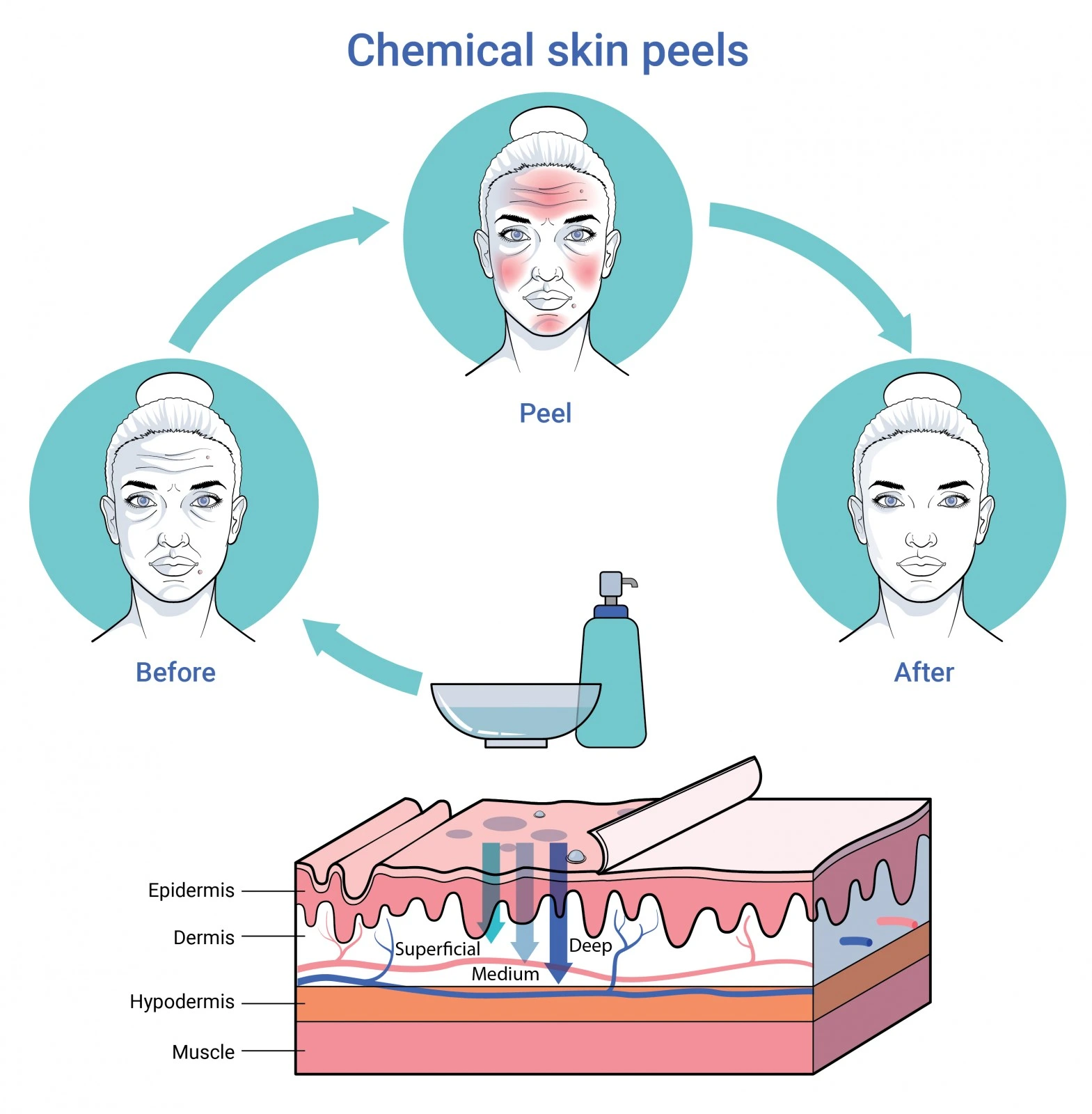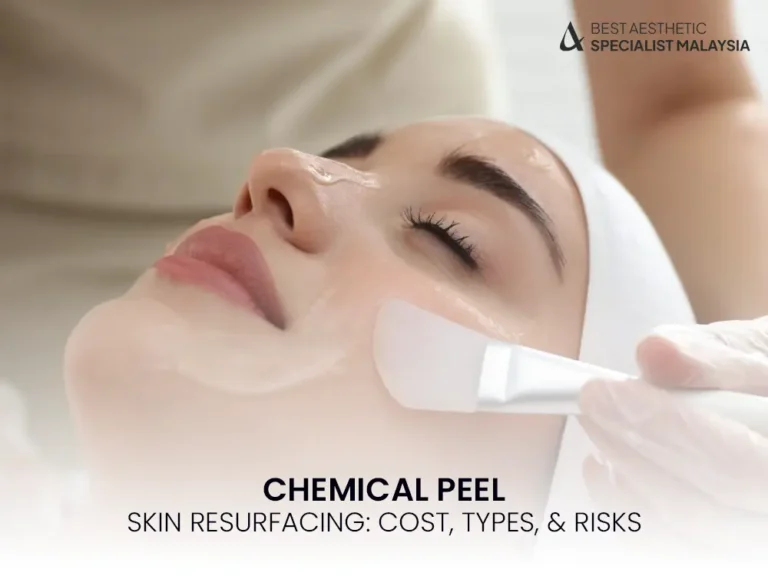What Is a Chemical Peel?
A chemical peel is a skincare treatment where a solution of acids is applied to the skin to exfoliate and remove damaged layers. This encourages cell regeneration, resulting in smoother, more youthful-looking skin.
Whether you’re dealing with acne scars, fine lines, dark spots, or just want a glowing complexion, chemical peels can be tailored to meet your skin’s needs.
In a systematic review of acne scar treatments, over 70% of patients receiving TCA CROSS (trichloroacetic acid “Chemical Reconstruction of Skin Scars”) achieved more than 70% improvement in scar appearance. journals.sagepub.com
Why Choose a Chemical Peel for Your Skin?

Chemical peels are popular because they address a wide range of skin concerns. Here are some common reasons people choose them:
-
Uneven skin tone or dullness
-
Sun damage or age spots
-
Fine lines and wrinkles
-
Acne and post-acne marks
-
Rough skin texture
-
Enlarged pores
Depending on the type and strength of the peel, results can be seen within days or weeks, offering visible skin improvements with minimal downtime.
Different Types of Chemical Peels
1. Superficial Peels
These use mild acids like glycolic acid or lactic acid to exfoliate only the outer layer of the skin. Ideal for beginners or those with sensitive skin, they require minimal recovery time.
2. Medium-Depth Peels
Using acids like trichloroacetic acid (TCA), these go deeper into the skin, targeting more pronounced sun damage, wrinkles, and discoloration. Expect a week or more of visible peeling and downtime.
3. Deep Peels
The most intense option, usually using phenol, deep peels penetrate the lower layers of the dermis. They are used for deeper wrinkles, scars, or severe sun damage. Healing may take several weeks, and these are performed under strict medical supervision.
How a Chemical Peel Procedure Works
-
Preparation: Your skin is cleaned and prepped. Some may need to prep for weeks using retinoids or other creams.
-
Application: The acid solution is applied for a set time, depending on your skin and the type of peel. You may feel tingling or warmth.
-
Neutralization and Rinse: The peel is neutralized and removed. Moisturizer and sunscreen are typically applied after.
-
Post-Treatment Care: Expect redness, peeling, or dryness for several days. Sun protection is essential during recovery.
Benefits of Chemical Peels for Skin Health

The results of chemical peels can be both immediate and long-lasting:
-
Brighter, more even skin tone
-
Reduction in fine lines and wrinkles
-
Less noticeable acne scars and blemishes
-
Minimized appearance of pores
-
Enhanced skin texture and smoothness
-
Boosted collagen production with repeated treatments
Many clients also report that their skincare products work better after a peel because the active ingredients can penetrate more easily.
Chemical Peel Safety, Risks, and Side Effects
Chemical peels are generally considered safe when performed by a qualified dermatologist or LCP-certified aesthetic doctor. The procedure uses controlled concentrations of acids such as glycolic, salicylic, lactic, TCA, or phenol, which are carefully applied to exfoliate and rejuvenate the skin.
Like any medical treatment, chemical peels come with potential risks and side effects. Common, temporary effects include redness, mild swelling, stinging, dryness, or skin peeling in the first few days. These reactions are part of the normal healing process as new skin surfaces.
In rare cases, complications may occur such as prolonged hyperpigmentation (dark spots), hypopigmentation (light patches), scarring, or infection—especially if aftercare instructions are not followed. Deeper peels, such as phenol peels, carry higher risks and require longer recovery.
To minimize risks, patients should undergo chemical peels only at certified aesthetic clinics, disclose their medical history (including medications like isotretinoin), and follow strict pre- and post-peel care. Sun protection is crucial, as the skin is more sensitive to UV damage during recovery.
Who Is a Good Candidate for a Chemical Peel?
Chemical peels are generally safe for:
-
Individuals with fair to medium skin tones
-
Those looking to improve skin clarity and texture
-
People with acne-prone or aging skin
They might not be suitable if you:
-
Have very dark skin (higher risk of post-treatment pigmentation)
-
Are pregnant or breastfeeding
-
Have eczema, rosacea, or active infections
-
Recently used Accutane or certain acne medications
Always consult a dermatologist or licensed professional to evaluate your skin and medical history before booking a peel.
What Results Can You Expect After a Chemical Peel?
After the procedure, your skin may be:
-
Red or sensitive, like a mild sunburn
-
Peeling or flaking for several days, especially with medium or deep peels
-
More vulnerable to sunlight—daily sunscreen is non-negotiable
Recovery time varies by peel type. Superficial peels require no downtime, while medium and deep peels may involve up to 14 days of healing. Avoid exfoliating, sun exposure, and heavy makeup during recovery.
Chemical Peel vs. Other Skin Treatments
| Treatment | Downtime | Main Benefits | Best For |
|---|---|---|---|
| Chemical Peels | 0–14 days | Exfoliation, tone correction, anti-aging | Broad skin issues, including acne |
| Microneedling | 2–5 days | Collagen boost, scar treatment | Fine lines, texture, and scars |
| Laser Resurfacing | 5–14 days | Deep rejuvenation, wrinkle reduction | Advanced aging or sun damage |
| Hydrafacial | None | Hydration, glow, deep cleansing | Sensitive or dehydrated skin |
Before:
-
Avoid sun exposure or tanning beds
-
Stop using retinol or strong exfoliants 3–5 days before
-
Discuss your medical history and skin goals with your provider
After:
-
Use a gentle cleanser and moisturizer
-
Avoid active ingredients like retinol or AHAs for a week
-
Don’t pick at peeling skin
-
Wear SPF 30 or higher every day
How Much Does A Chemical Peel Cost In Malaysia?
In Malaysia, chemical peel prices vary depending on the type of peel, clinic reputation, and doctor’s expertise. On average:
| Type of Chemical Peel | Price Range (per session) | Details |
|---|---|---|
| Superficial Peel (glycolic, lactic, salicylic) | RM 200 – RM 500 | Light exfoliation, minimal downtime, suitable for mild acne, dull skin, or uneven tone. |
| Medium Peel (TCA, stronger glycolic) | RM 600 – RM 1,500 | Targets deeper pigmentation, acne scars, and wrinkles; requires short downtime. |
| Deep Peel (phenol, high-concentration TCA) | RM 2,000 – RM 5,000+ | Intensive treatment for severe wrinkles or deep scars; longer recovery, medical supervision required. |
💡 Pricing Factors in Malaysia
-
Treatments in Kuala Lumpur and Selangor tend to be slightly higher due to demand and clinic location.
-
LCP-certified doctors may charge more, but they provide safer and more effective results.
-
Packages (multiple sessions) are often offered at discounted rates compared to single sessions.
⚠️ While cost is important, patients are advised to prioritize safety, expertise, and clinic certification to avoid complications.
FAQs About Chemical Peels
1. How long does a chemical peel last?
Results from a superficial peel can last a few weeks, while medium and deep peels may offer results that last months to years with good skincare habits.
2. Do chemical peels hurt?
You may feel a stinging or burning sensation during the peel, especially with stronger acids. Most discomfort is mild and temporary.
3. Can I go back to work the next day?
With light peels, yes. Medium and deep peels may require time off due to visible redness and peeling.
4. How often should I get a peel?
Mild peels can be done every 4–6 weeks. Deeper peels should be spaced several months apart.
5. Are there any risks?
Mild redness, sensitivity, and peeling are common. In rare cases, scarring or hyperpigmentation can occur, especially with improper aftercare.
Final Thoughts
Chemical peels are a powerful tool for improving your skin’s appearance and texture. When performed by trained professionals, they are safe, effective, and customizable. Whether you’re new to skincare or seeking to correct long-term issues, chemical peels offer a non-invasive route to healthier, glowing skin.

